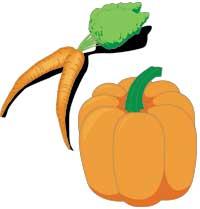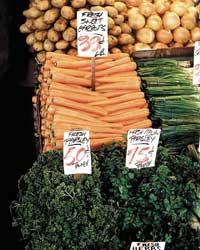Carrot and pumpkin

Carrot is the root of the plant of the same name. It is usually orange, but they are also yellowish varieties. A is the food with more provitamin or beta carotene.
For its part, pumpkin is the fruit of the family pumpkin plant. It can be circular, oval, bottled... The skin can be orange, yellow, green, white, black or purple. The miga or internal meat is usually orange or yellow and has seeds inside.
Carrots and squash provide very little energy. In its composition predominate, besides water, carbohydrates, while the amount of proteins and fats is very reduced.
The substances mentioned below are responsible for the production of two vegetables:
Carotenoids

Beta carotene that is mainly transformed into vitamin A in our body. Carotenes are essential for the proper functioning of the ocular retina, especially when it comes to night vision. A study conducted by the Harvard University of the United States has shown that foods high in beta carotene, with an adequate amount of potassium (as in the case of carrots and pumpkin), prevent the formation of cataracts in the crystalline.
Vegetable fibres
Most of it is pectin. Improves intestinal mucosa and mobility, avoiding intestinal cancer.
Low sodium and high potassium content
Especially pumpkins. For this characteristic they are highly recommended for people with hypertension and arterial problems. In case of hypertension, it is advisable to reduce sodium and increase potassium, which is achieved with these foods.

To protect the arteries it is necessary, in addition to reducing fat and sodium, to take antioxidant vitamins such as beta carotene. Therefore, both carrots and squash are very important for people with arterial problems. In these cases it is recommended to take pumpkin at least 3 times per week.
Forms of preparation
- They can be eaten raw in salad, chopped or crushed.
- Cooked as an accompaniment of any vegetables or sheath. For example, if we prepare leek potatoes, chard or lentils, it is very healthy to add pieces of pumpkin and carrot.
- Cooked and in puree: Cook the carrot and pumpkin, go to the puree and add a little oil. If you want to enhance the flavor, you can add a glass of milk.
- To accompany meat, fish or egg: it can be completed with peas, mushrooms and other vegetables.
- Carrot and pumpkin juice is also very good. You can also use apple or other fruits like pomegranate, pear...
In 1913 vitamin A was first discovered. Of the liposoluble vitamins known today (A, D, E, K) was the first that they discovered. In animal products it is in the form of retinol in foods such as liver, kidneys, margarine, eggs, dairy, butter and fish liver oil. As for the derivatives of the plants, we find them in the form of carotene, especially in vegetables and fruits of yellow or orange color: carrot, pumpkin, apricots… The more orange it is, the more carotene they contain. Vitamin A has very important functions in the visual cones and sticks. It also contributes to the formation of the skin, producing skin cells. It is also antioxidant and therefore protects against infections and cancers. Finally, he participates in the formation and development of bones. It is recommended to take another vitamin A daily: Children 0-10 years 400-700 ug RE+ Adults: Men 1000 ug RE Women* 800 ug RE
Low intake of vitamin A may result in:
However, it is also not convenient to take too much vitamin A. This is because being fat-soluble tends to accumulate in the body and especially in the liver, so an abuse can cause problems. This is difficult, since very high amounts of 15,000 RE must be ingested, but it has occurred in people who have taken vitamin A as a drug. In these cases appear symptoms such as decreased appetite, hair loss, increased liver and spleen, etc. Therefore, be careful with medications or supplements that contain vitamin A. |
Composition of the carrot
Energy kcal/100 g43Protein g/100 g1,03Fat g/100 g0,19Carbohydrates g/100g7,14Water 87.8% Fiber g/100 gBeta carotene ug RE2.813Potassium mg/100 g323Sodium/100 g35 Pumpkin composition Energy kcal/100 g26Protein/1100 gCat




